Local Knowledge about Ecosystem Services Provided by Trees in Coffee Agroforestry Practices in Northwest Vietnam
Abstract
1. Introduction
2. Materials and Methods
2.1. Study Sites
2.2. Data Collection
2.3. Data Analysis
3. Results
3.1. Farm Characteristics of Coffee Agroforestry Systems
3.2. Tree Species Inventory in Coffee Agroforestry Systems
3.3. Tree Species Richness in Coffee Farms
3.4. Variation in Shade Tree Species Composition of Coffee Farms in Relation to Proximity to Main Roads
3.5. Farmer Perspectives on Ecosystem Services Associated with Trees in Coffee Systems
3.6. Tree Species Pairwise Ranking
4. Discussion
4.1. Tree Diversity in Coffee Agroforestry Systems
4.2. Tree Ranking and Farmer’s Perception on Tree Services or Disservices
4.3. The Relevance of Tree Knowledge and Tree Biophysical Suitability
4.4. Gender, Ethnicity and Tree Selection
5. Conclusions
Author Contributions
Funding
Acknowledgments
Conflicts of Interest
Appendix A
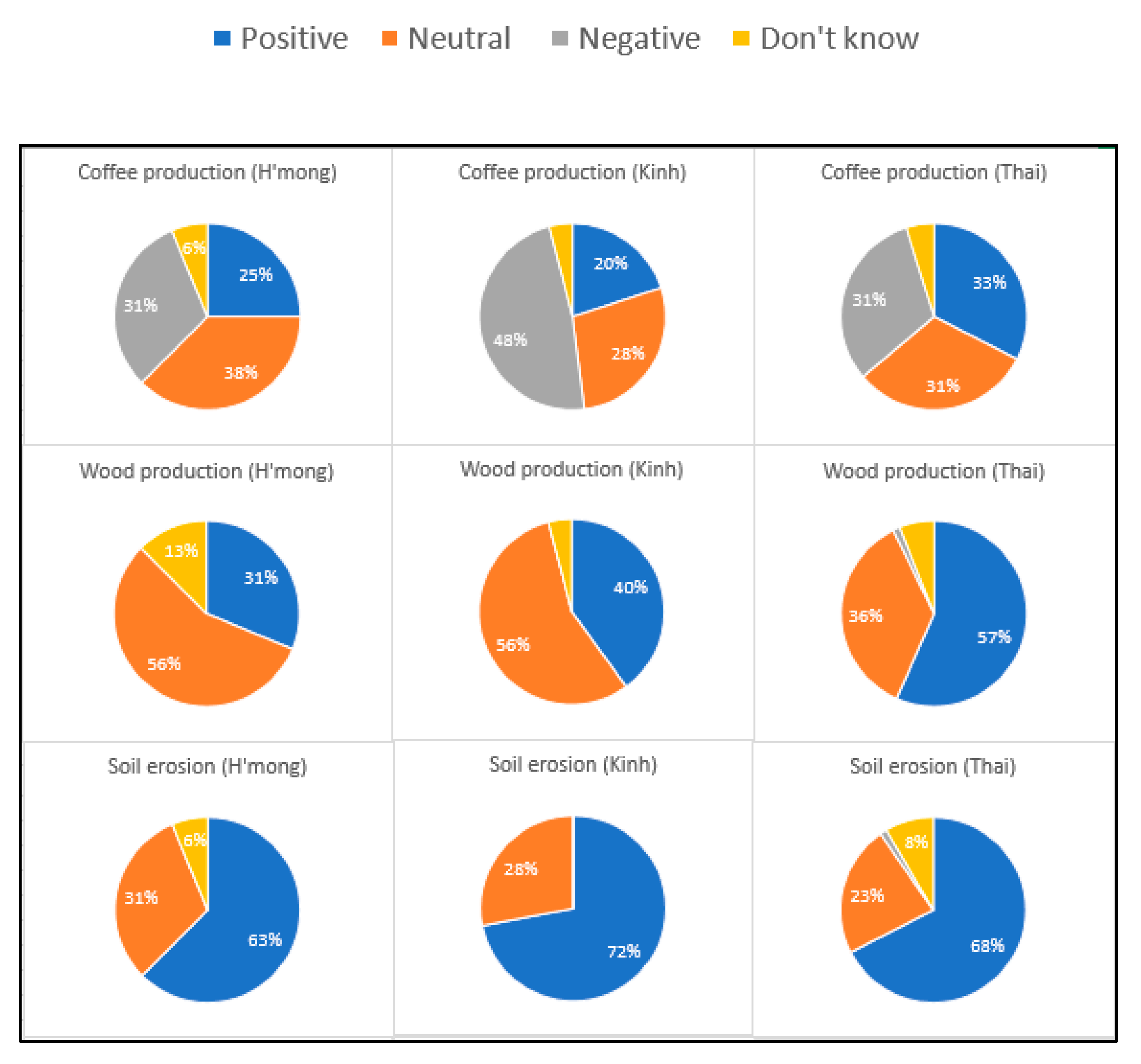
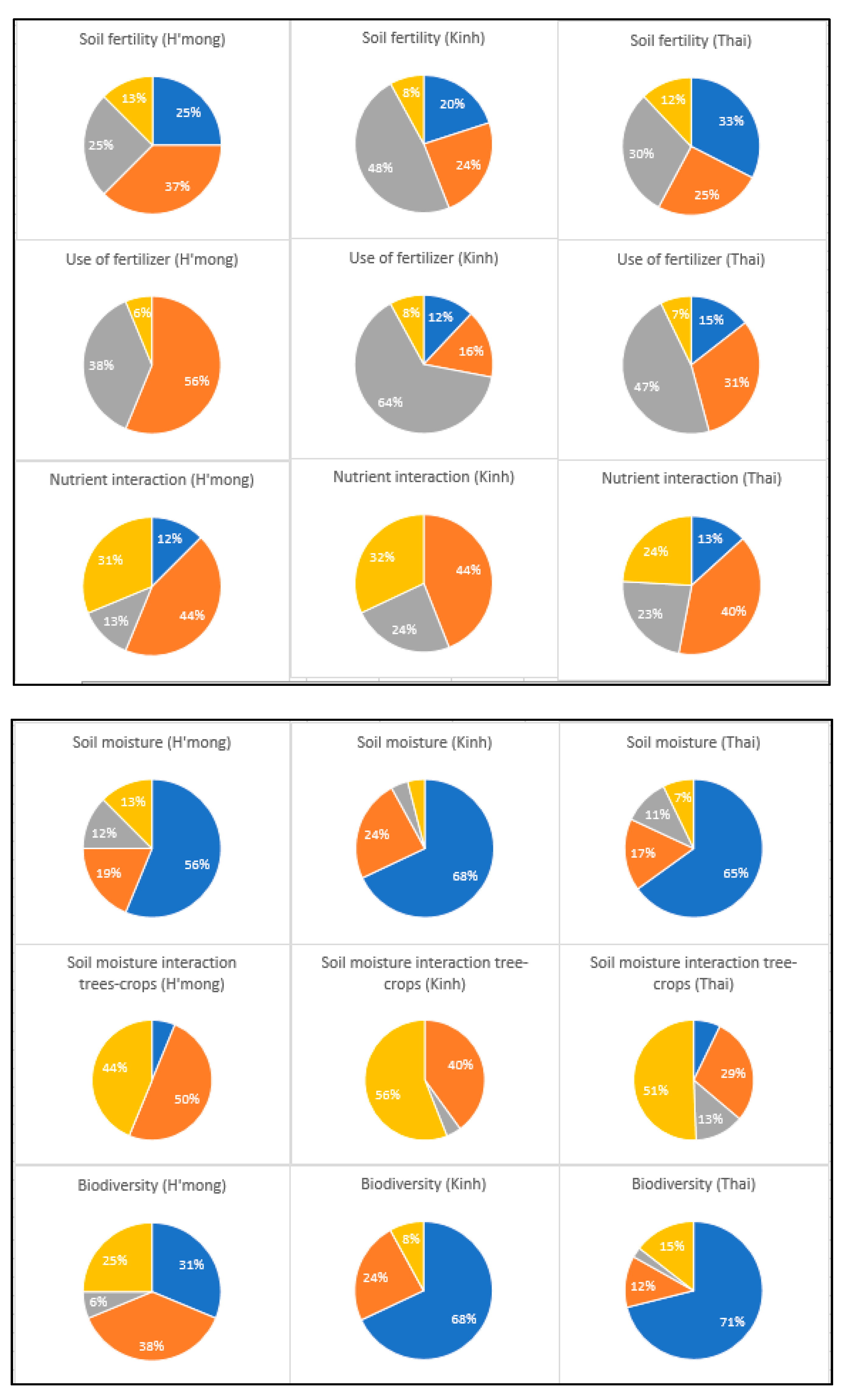
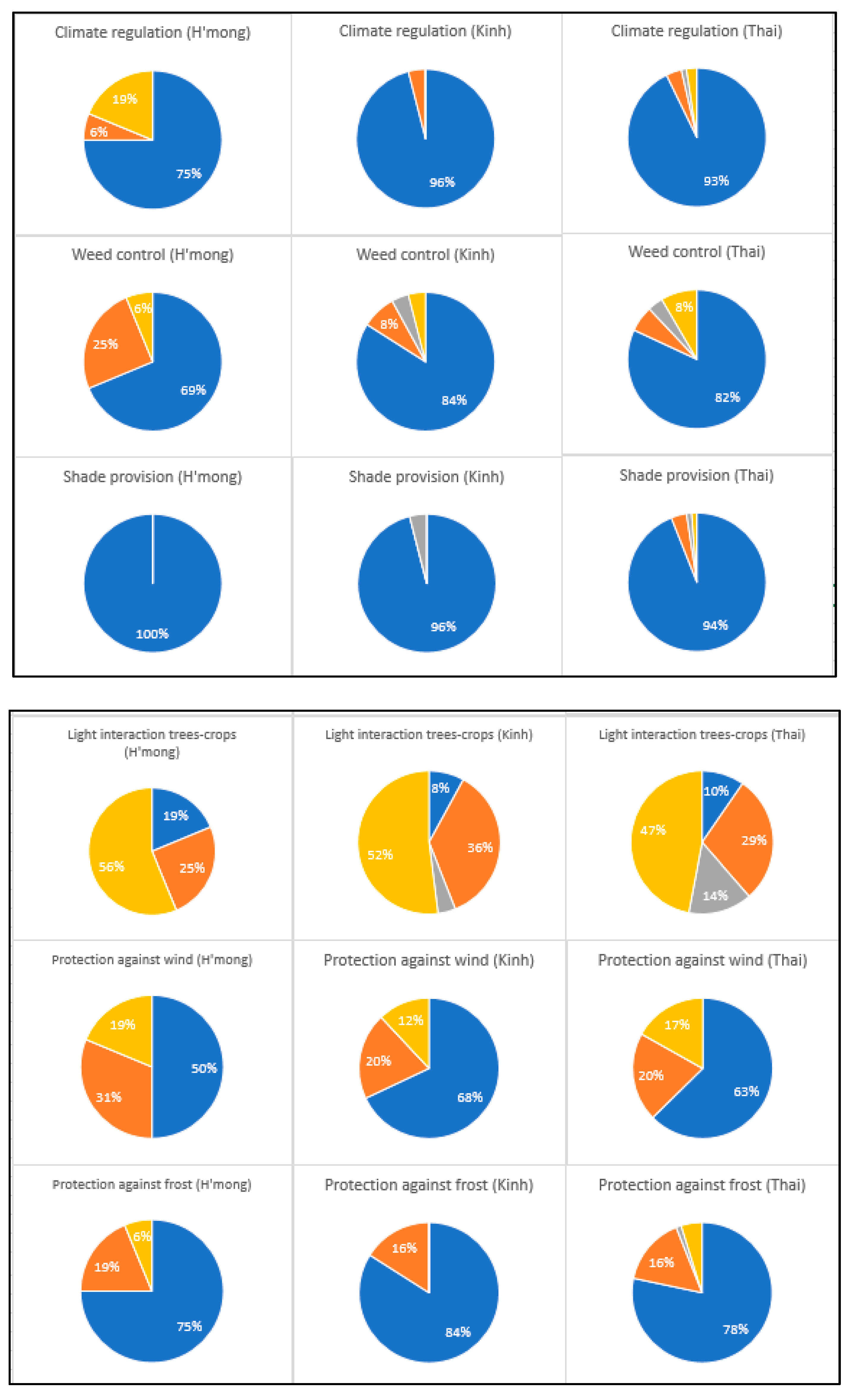
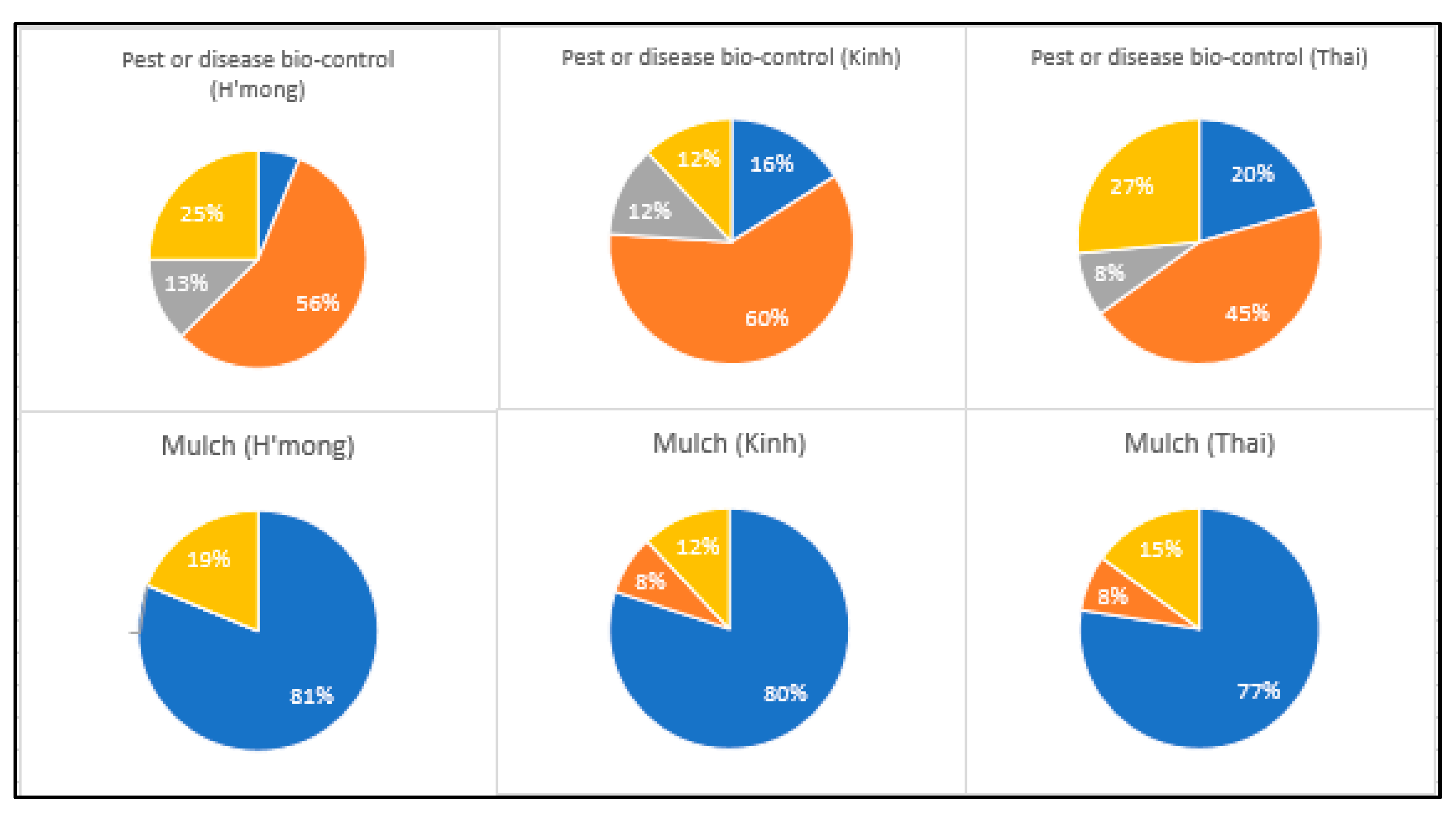
Appendix B
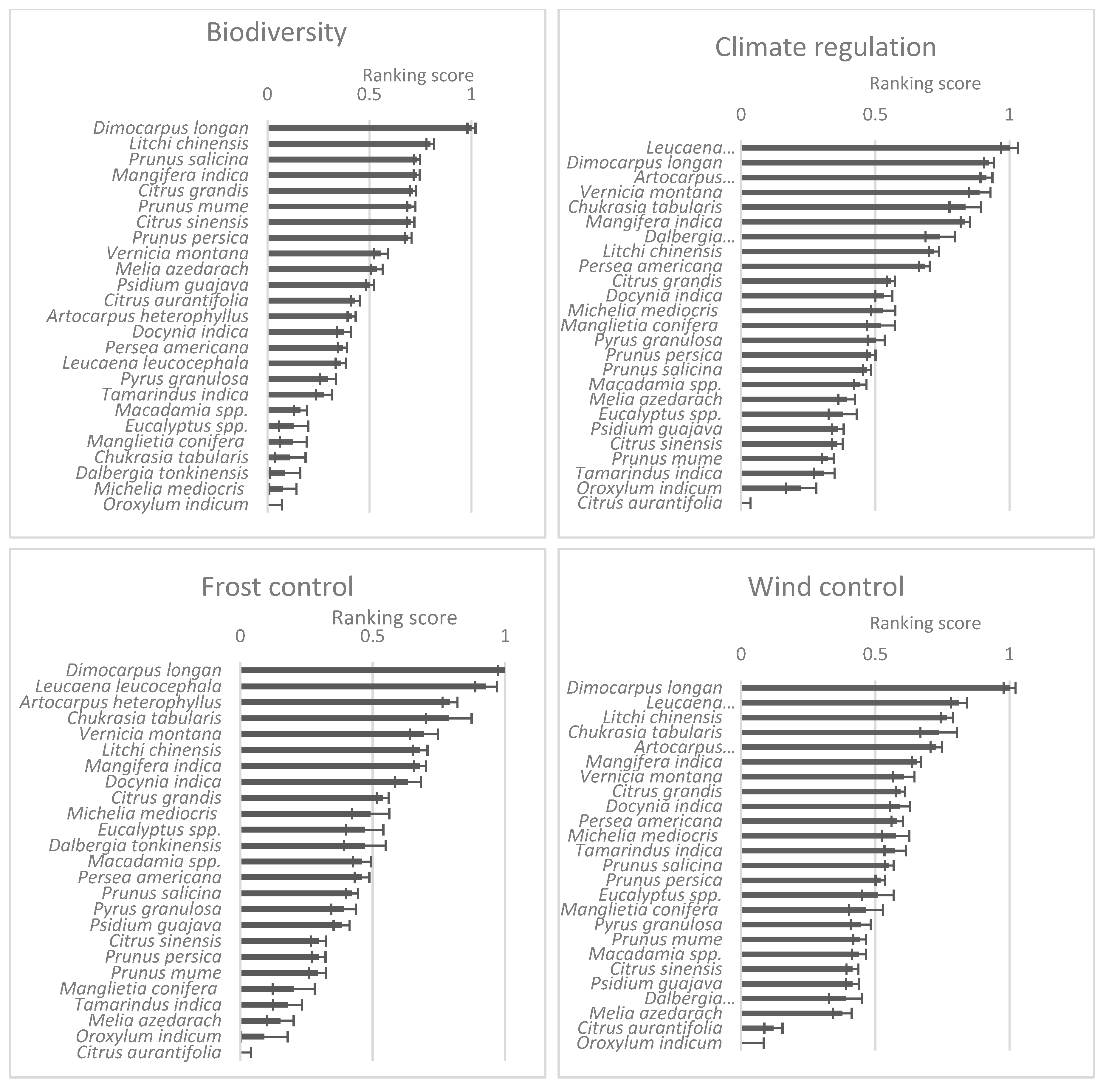
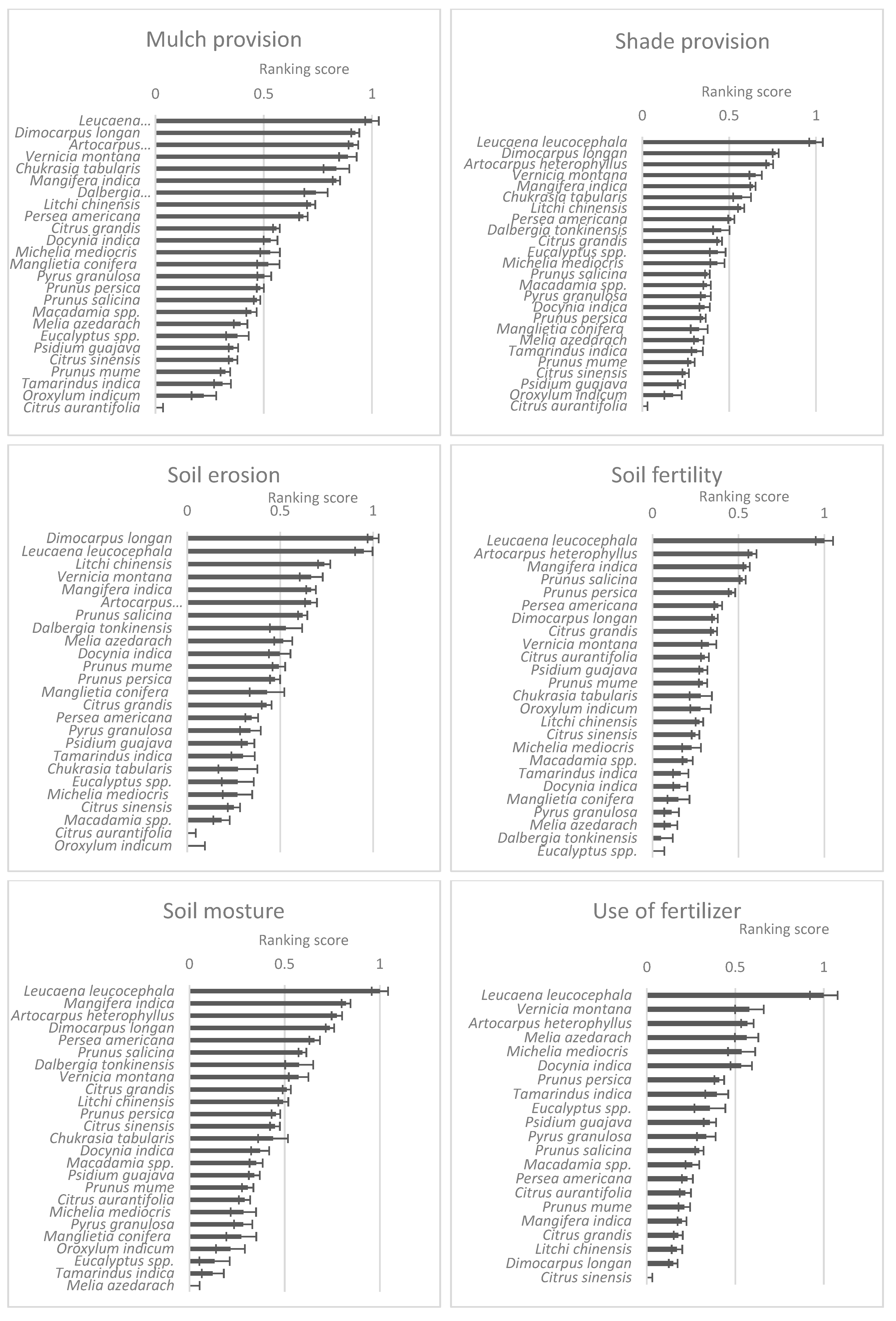

Appendix C
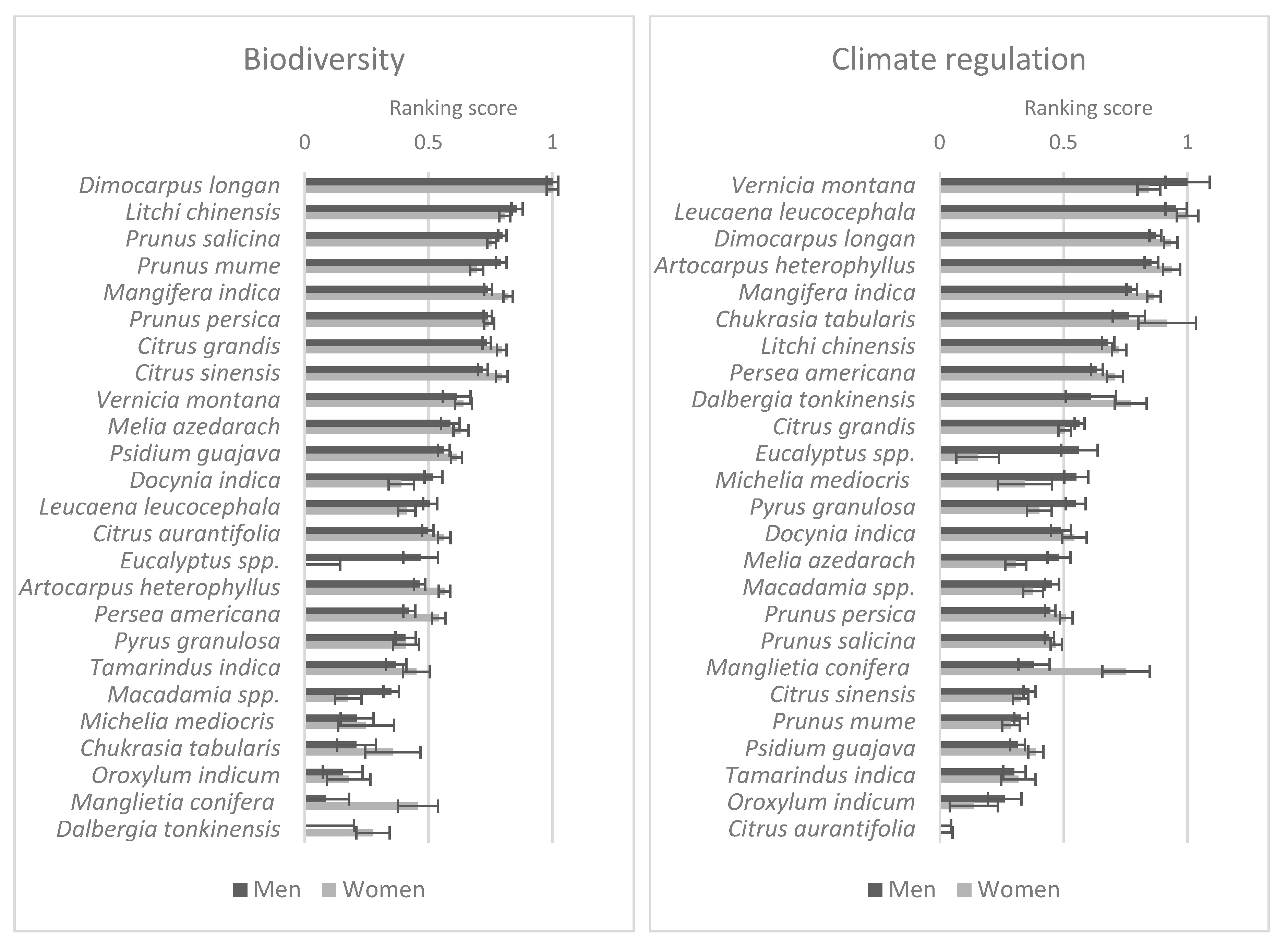
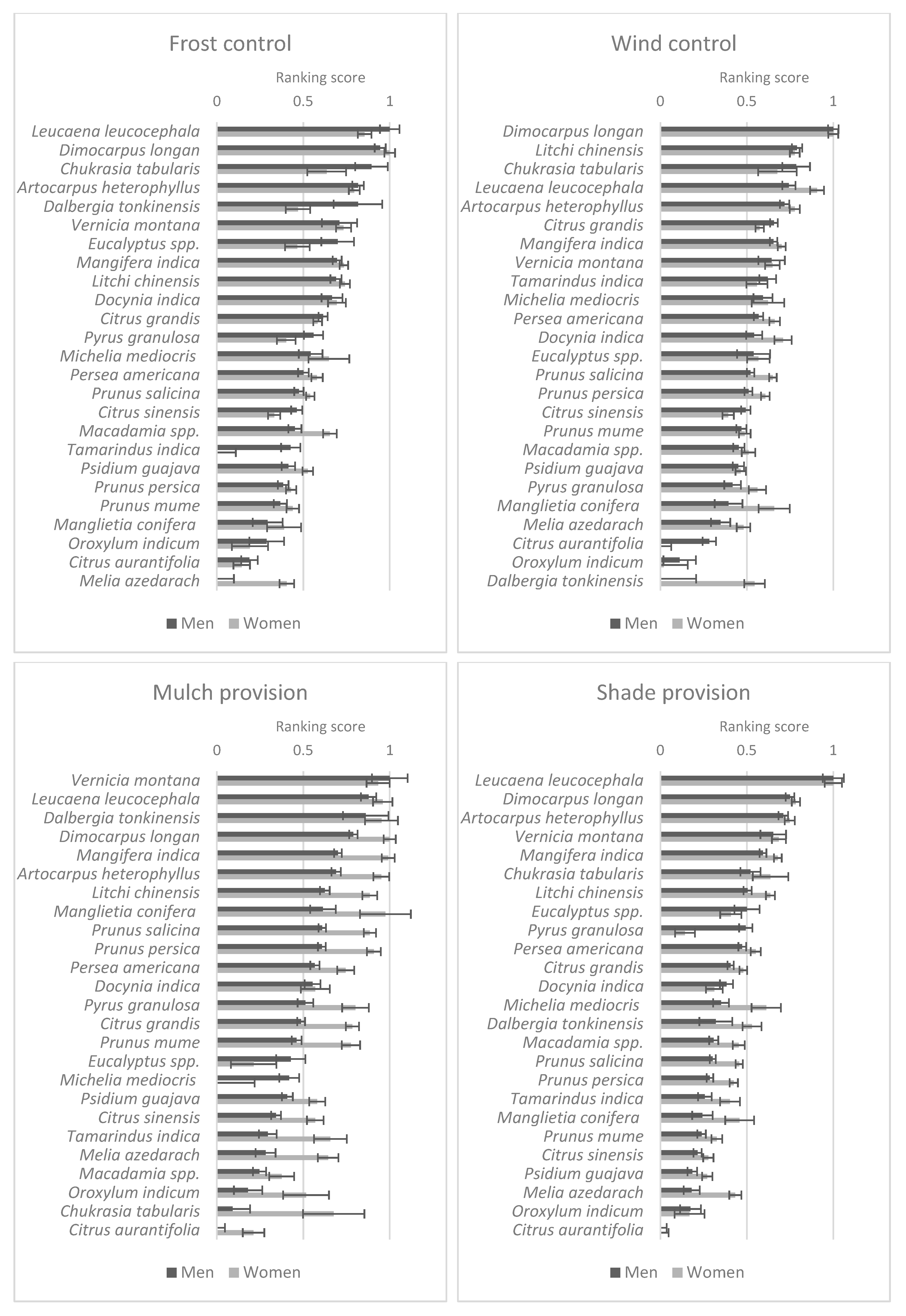
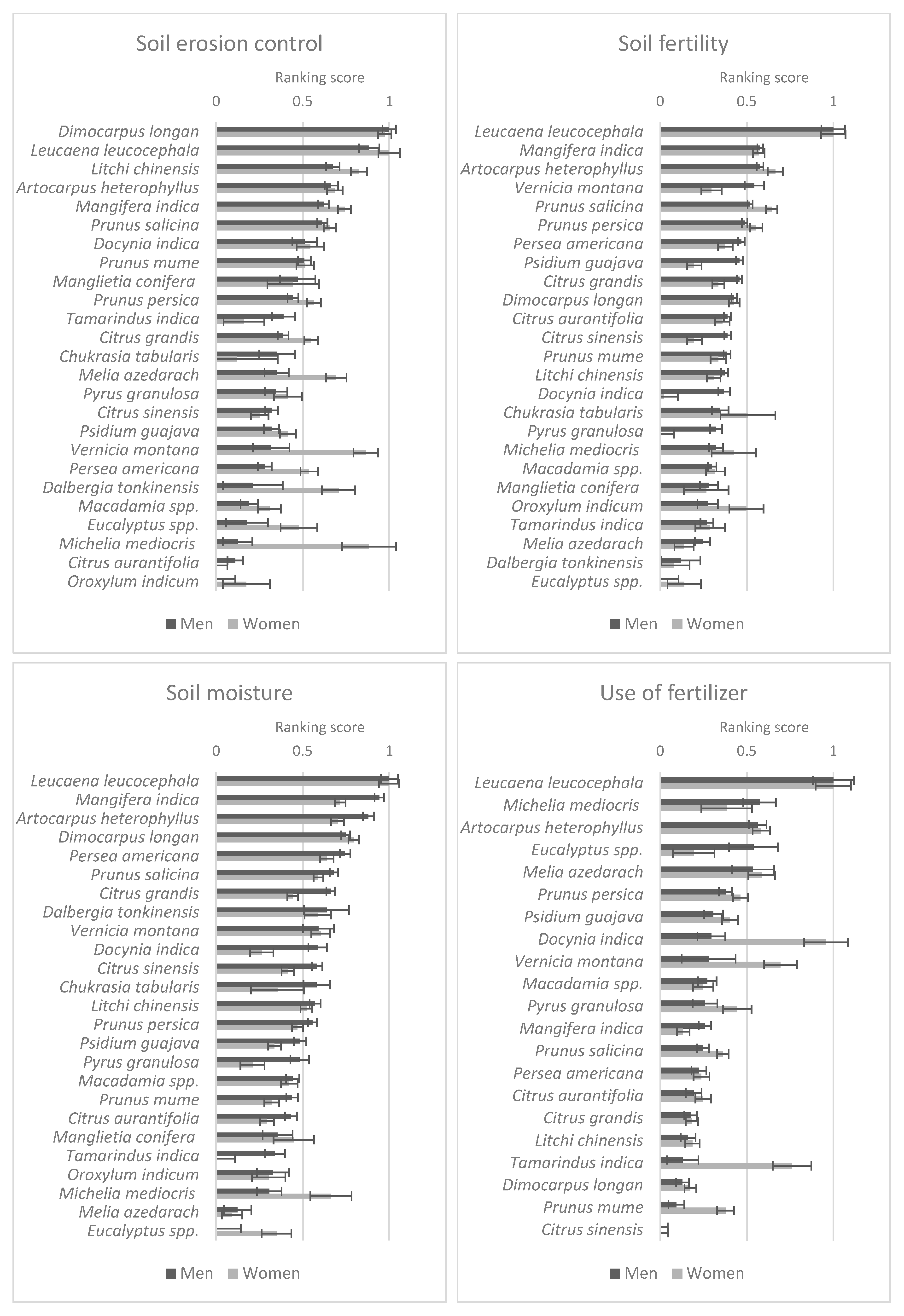

Appendix D
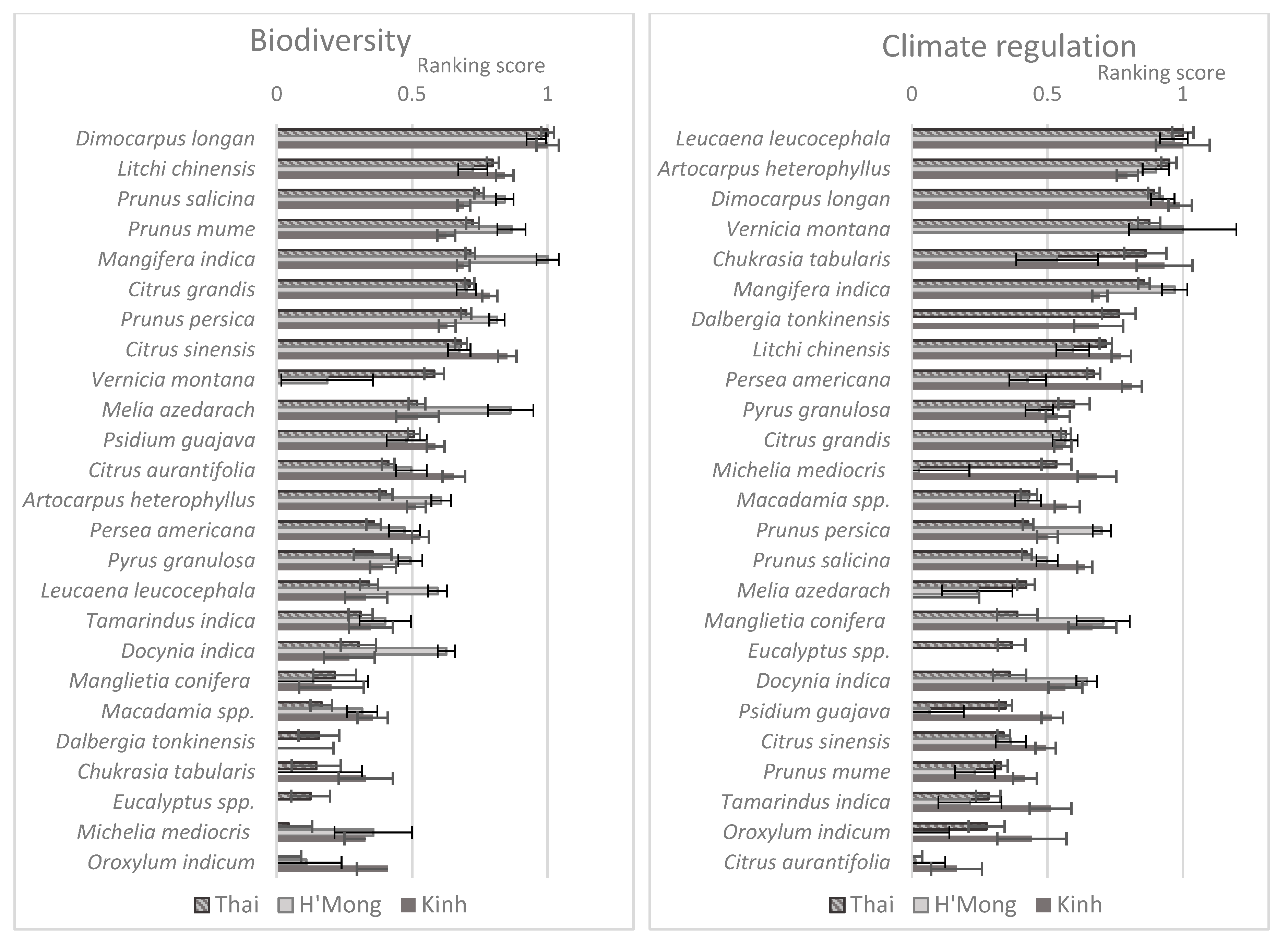

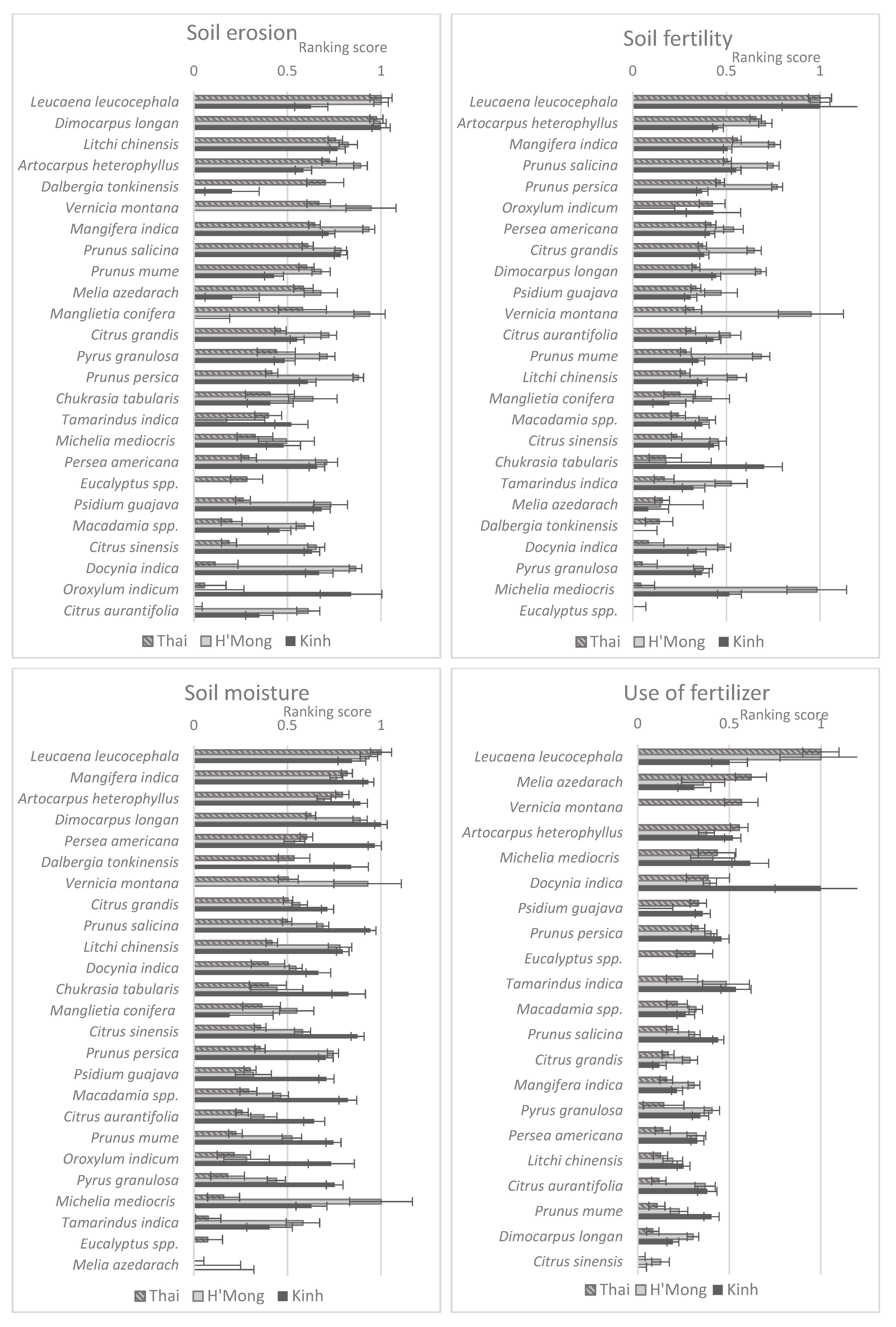

References
- Tucker, C.M. Coffee Culture: Local Experiences, Global Connections, 2nd ed.; Taylor & Francis: Abingdon, UK, 2017; ISBN 9781317392255. [Google Scholar]
- Food and Agriculture Organization of the United Nations. FAOSTAT Statistical Database 2018; Food and Agriculture Organization of the United Nations: Rome, Italy, 2018. [Google Scholar]
- International Coffee Organization. ICO Annual Review 2010/11 2011; International Coffee Organization: London, UK, 2011. [Google Scholar]
- Amarasinghe, U.A.; Hoanh, C.T.; D’haeze, D.; Hung, T.Q. Toward sustainable coffee production in Vietnam: More coffee with less water. Agric. Syst. 2015, 136, 96–105. [Google Scholar] [CrossRef]
- Vietnam Ministry of Agriculture and Rural Development. Report on Crop Production in Vietnam; Crop Production Department: Ha Noi, Vietnam, 2017.
- Vietnam Customs. Vietnam International Merchandise Trade Statistics 2018; Vietnam Customs: Ha Noi, Vietnam, 2018. [Google Scholar]
- International Coffee Organization. Country Coffee Profile: Vietnam; International Coffee Organization: London, UK, 2019. [Google Scholar]
- General Statistics Office of Dien Bien Province. Agriculture, Fishery and Forestry Census 2018; General Statistics Office of Dien Bien Province: Vietnam, 2018.
- General Statistics Office of Son La Province. Agriculture, Fishery and Forestry Census 2018; General Statistics Office of Son La Province: Vietnam, 2018.
- Nghiem, T.; Kono, Y.; Leisz, S.J. The Case of Coffee Production in the Northern Mountain Region of Vietnam. Land 2020, 9, 56. [Google Scholar] [CrossRef]
- Perfecto, I.; Rice, R.A.; Greenberg, R.; Van Der Voort, M.E. Shade coffee: A disappearing refuge for biodiversity: Shade coffee plantations can contain as much biodiversity as forest habitats. Bioscience 1996, 46, 598–608. [Google Scholar] [CrossRef]
- Haggar, J.; Barrios, M.; Bolaños, M.; Merlo, M.; Moraga, P.; Munguia, R.; Ponce, A.; Romero, S.; Soto, G.; Staver, C.; et al. Coffee agroecosystem performance under full sun, shade, conventional and organic management regimes in Central America. Agrofor. Syst. 2011, 82, 285–301. [Google Scholar] [CrossRef]
- Philpott, S.M.; Arendt, W.J.; Armbrecht, I.; Bichier, P.; Diestch, T.V.; Gordon, C.; Greenberg, R.; Perfecto, I.; Reynoso-Santos, R.; Soto-Pinto, L.; et al. Biodiversity loss in Latin American coffee landscapes: Review of the evidence on ants, birds, and trees. Conserv. Biol. 2008, 22, 1093–1105. [Google Scholar] [CrossRef]
- Vaast, P.; Harmand, J.-M.; Rapidel, B.; Jagoret, P.; Deheuvels, O. Coffee and Cocoa Production in Agroforestry—A Climate-Smart Agriculture Model. In Climate Change and Agriculture Worldwide; Torquebiau, E., Ed.; Springer: Dordrecht, The Netherlands, 2016; pp. 209–224. [Google Scholar]
- Sinclair, F.L. A general classification of agroforestry practice. Agrofor. Syst. 1999, 46, 161–180. [Google Scholar] [CrossRef]
- Boreux, V.; Kushalappa, C.G.; Vaast, P.; Ghazoul, J. Interactive effects among ecosystem services and management practices on crop production: Pollination in coffee agroforestry systems. Proc. Natl. Acad. Sci. USA 2013, 110, 8387–8392. [Google Scholar] [CrossRef]
- Somarriba, E.; Harvey, C.A.; Samper, M.; Anthony, F.; González, J.; Staver, C.; Rice, R.A. Biodiversity conservation in neotropical coffee (Coffea arabica) plantations. In Agroforestry and Biodiversity Conservation in Tropical Landscapes; Island Press: Washington, DC, USA, 2004; pp. 198–226. [Google Scholar]
- Jha, S.; Bacon, C.M.; Philpott, S.M.; Rice, R.A.; Méndez, V.E.; Läderach, P. A Review of Ecosystem Services, Farmer Livelihoods, and Value Chains in Shade Coffee Agroecosystems. In Integrating Agriculture, Conservation and Ecotourism: Examples from the Field; Campell, W.B., Ortiz, S.L., Eds.; Springer: Dordrecht, The Netherlands, 2011; pp. 141–208. [Google Scholar]
- Guillemot, J.; le Maire, G.; Munishamappa, M.; Charbonnier, F.; Vaast, P. Native coffee agroforestry in the Western Ghats of India maintains higher carbon storage and tree diversity compared to exotic agroforestry. Agric. Ecosyst. Environ. 2018, 265, 461–469. [Google Scholar] [CrossRef]
- Rahn, E.; Läderach, P.; Baca, M.; Cressy, C.; Schroth, G.; Malin, D.; van Rikxoort, H.; Shriver, J. Climate change adaptation, mitigation and livelihood benefits in coffee production: Where are the synergies? Mitig. Adapt. Strateg. Glob. Chang. 2014, 19, 1119–1137. [Google Scholar] [CrossRef]
- Davis, A.P.; Gole, T.W.; Baena, S.; Moat, J. The Impact of Climate Change on Indigenous Arabica Coffee (Coffea arabica): Predicting Future Trends and Identifying Priorities. PLoS ONE 2012, 7. [Google Scholar] [CrossRef]
- Schroth, G.; Laderach, P.; Dempewolf, J.; Philpott, S.; Haggar, J.; Eakin, H.; Castillejos, T.; Moreno, J.G.; Pinto, L.S.; Hernandez, R.; et al. Towards a climate change adaptation strategy for coffee communities and ecosystems in the Sierra Madre de Chiapas, Mexico. Mitig. Adapt. Strateg. Glob. Chang. 2009, 14, 605–625. [Google Scholar] [CrossRef]
- Vaast, P.; Van Kanten, R.; Siles, P.; Dzib, B.; Franck, N.; Harmand, J.M.; Genard, M. Shade: A Key Factor for Coffee Sustainability and Quality. In Proceedings of the 20th International Conference on Coffee Science, Bangalore, India, 11–15 October 2004. [Google Scholar]
- Mancuso, M.A.C.; Soratto, R.P.; Perdoná, M.J. Shaded coffee production. Colloq. Agrar. 2013, 9, 31–44. [Google Scholar] [CrossRef][Green Version]
- Meylan, L.; Gary, C.; Allinne, C.; Ortiz, J.; Jackson, L.; Rapidel, B. Evaluating the effect of shade trees on provision of ecosystem services in intensively managed coffee plantations. Agric. Ecosyst. Environ. 2017, 245, 32–42. [Google Scholar] [CrossRef]
- Roupsard, O.; Van Den Meersche, K.; Allinne, C.; Vaast, P.; Rapidel, B.; Avelino, J.; Jourdan, C.; Le Maire, G.; Bonnefond, J.-M.; Harmand, J.-M.; et al. Eight years studying ecosystem services in a coffee agroforestry observatory. Practical applications for the stakeholders. In Proceedings of the World Coffee Summit, San Salvador, Salvador, 31 May–3 June 2017. [Google Scholar]
- Cerdán, C.R.; Rebolledo, M.C.; Soto, G.; Rapidel, B.; Sinclair, F.L. Local knowledge of impacts of tree cover on ecosystem services in smallholder coffee production systems. Agric. Syst. 2012, 110, 119–130. [Google Scholar] [CrossRef]
- Lamond, G.; Sandbrook, L.; Gassner, A.; Sinclair, F.L. Local knowldge of tree attreibutes underpins sepcies selection on coffee farms. Exp. Agric. 2019, 55, 35–49. [Google Scholar] [CrossRef]
- Valencia, V.; West, P.; Sterling, E.J.; García-Barrios, L.; Naeem, S. The use of farmers’ knowledge in coffee agroforestry management: Implications for the conservation of tree biodiversity. Ecosphere 2015, 6, 1–17. [Google Scholar] [CrossRef]
- Dumont, E.S.; Bonhomme, S.; Pagella, T.F.; Sinclair, F.L. Structured stakeholder engagement leads to development of more diverse and inclusive agroforestry options. Exp. Agric. 2019, 55, 252–274. [Google Scholar] [CrossRef]
- Van Der Wolf, J.; Jassogne, L.; Gram, G.I.L.; Vaast, P. Turning local knowledge on agroforestry into an online decision-support tool for tree selection smallholger’s farms. Exp. Agric. 2019, 55, 50–66. [Google Scholar] [CrossRef]
- Rigal, C.; Vaast, P.; Xu, J. Using farmers’ local knowledge of tree provision of ecosystem services to strengthen the emergence of coffee-agroforestry landscapes in southwest China. PLoS ONE 2018, 13. [Google Scholar] [CrossRef]
- Smith Dumont, E.; Gassner, A.; Agaba, G.; Nansamba, R.; Sinclair, F. The utility of farmer ranking of tree attributes for selecting companion trees in coffee production systems. Agrofor. Syst. 2019, 93, 1469–1483. [Google Scholar] [CrossRef]
- Kindt, R.; Coe, R. Tree Diversity Analysis: A Manual and Software for Common Statistical Methods for Ecological and Biodiversity Studies; World Agroforestry Centre: Nairobi, Kenya, 2005. [Google Scholar]
- Turner, H.; Firth, D. Bradley-terry models in R: The bradleyterry2 package. J. Stat. Softw. 2012, 48. [Google Scholar] [CrossRef]
- Carsan, S.; Stroebel, A.; Dawson, I.; Kindt, R.; Swanepoel, F.; Jamnadass, R. Implications of shifts in coffee production on tree species richness, composition and structure on small farms around Mount Kenya. Biodivers. Conserv. 2013, 22, 2919–2936. [Google Scholar] [CrossRef]
- Nyaga, J.; Barrios, E.; Muthuri, C.W.; Öborn, I.; Matiru, V.; Sinclair, F.L. Evaluating factors influencing heterogeneity in agroforestry adoption and practices within smallholder farms in Rift Valley, Kenya. Agric. Ecosyst. Environ. 2015, 212, 106–118. [Google Scholar] [CrossRef]
- Soto-Pinto, L.; Villalvazo-López, V.; Jiménez-Ferrer, G.; Ramírez-Marcial, N.; Montoya, G.; Sinclair, F.L. The role of local knowledge in determining shade composition of multistrata coffee systems in Chiapas, Mexico. Biodivers. Conserv. 2007, 16, 419–436. [Google Scholar] [CrossRef]
- Meyfroidt, P.; Lambin, E.F.; Erb, K.H.; Hertel, T.W. Globalization of land use: Distant drivers of land change and geographic displacement of land use. Curr. Opin. Environ. Sustain. 2013, 5, 438–444. [Google Scholar] [CrossRef]
- Beer, J. Litter production and nutrient cycling in coffee (Coffea arabica) or cacao (Theobroma cacao) plantations with shade trees. Agrofor. Syst. 1988, 7, 103–114. [Google Scholar] [CrossRef]
- Vaast, P.; van Kanten, R.; Siles, P.; Angrand, J.; Aguilar, A. Biophysical Interactions Between Timber Trees and Arabica Coffee in Suboptimal Conditions of Central America. In Toward Agroforestry Design; Jose, S., Gordon, A.M., Eds.; Springer: Dordrecht, The Netherlands, 2008; pp. 133–146. [Google Scholar]

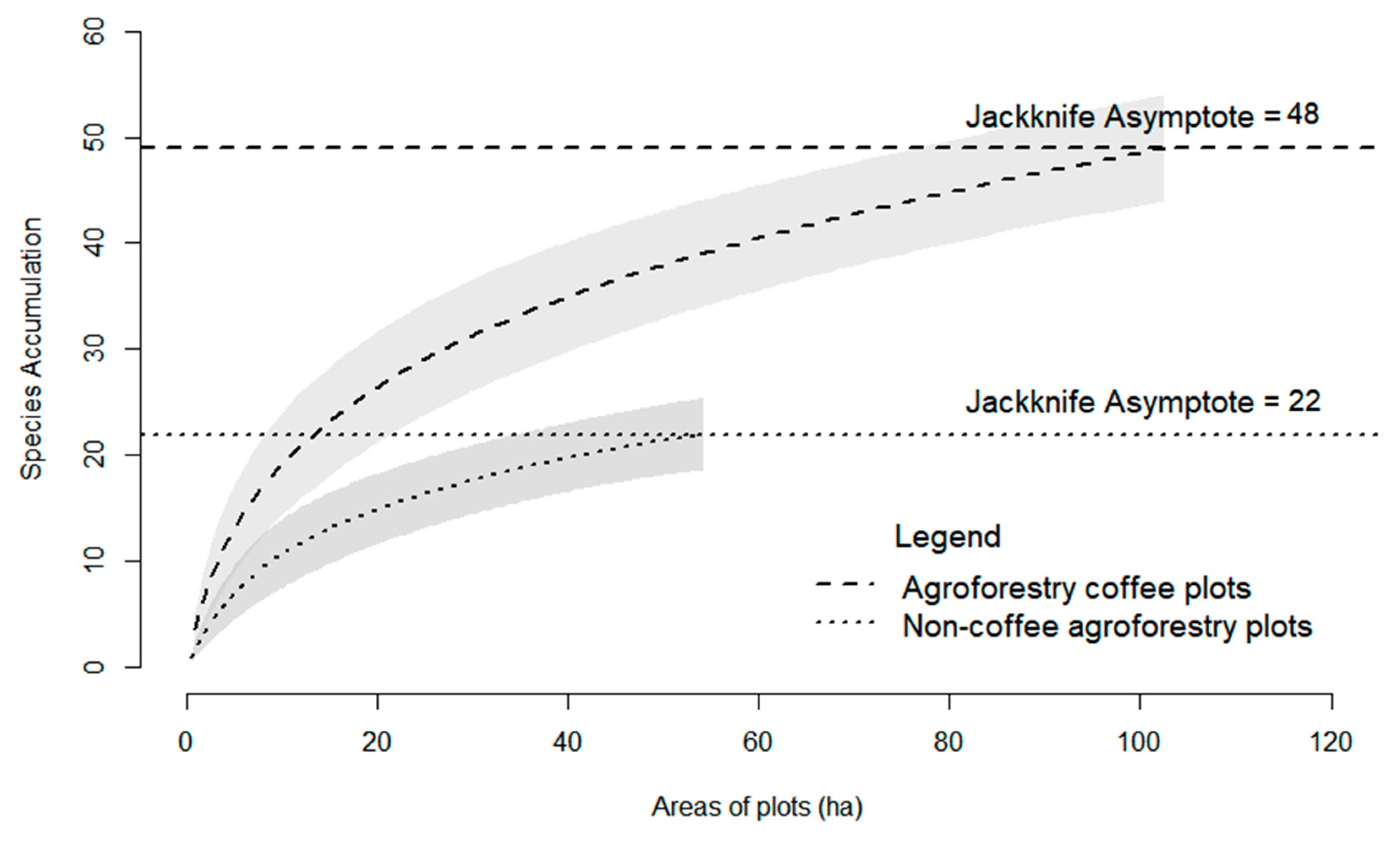
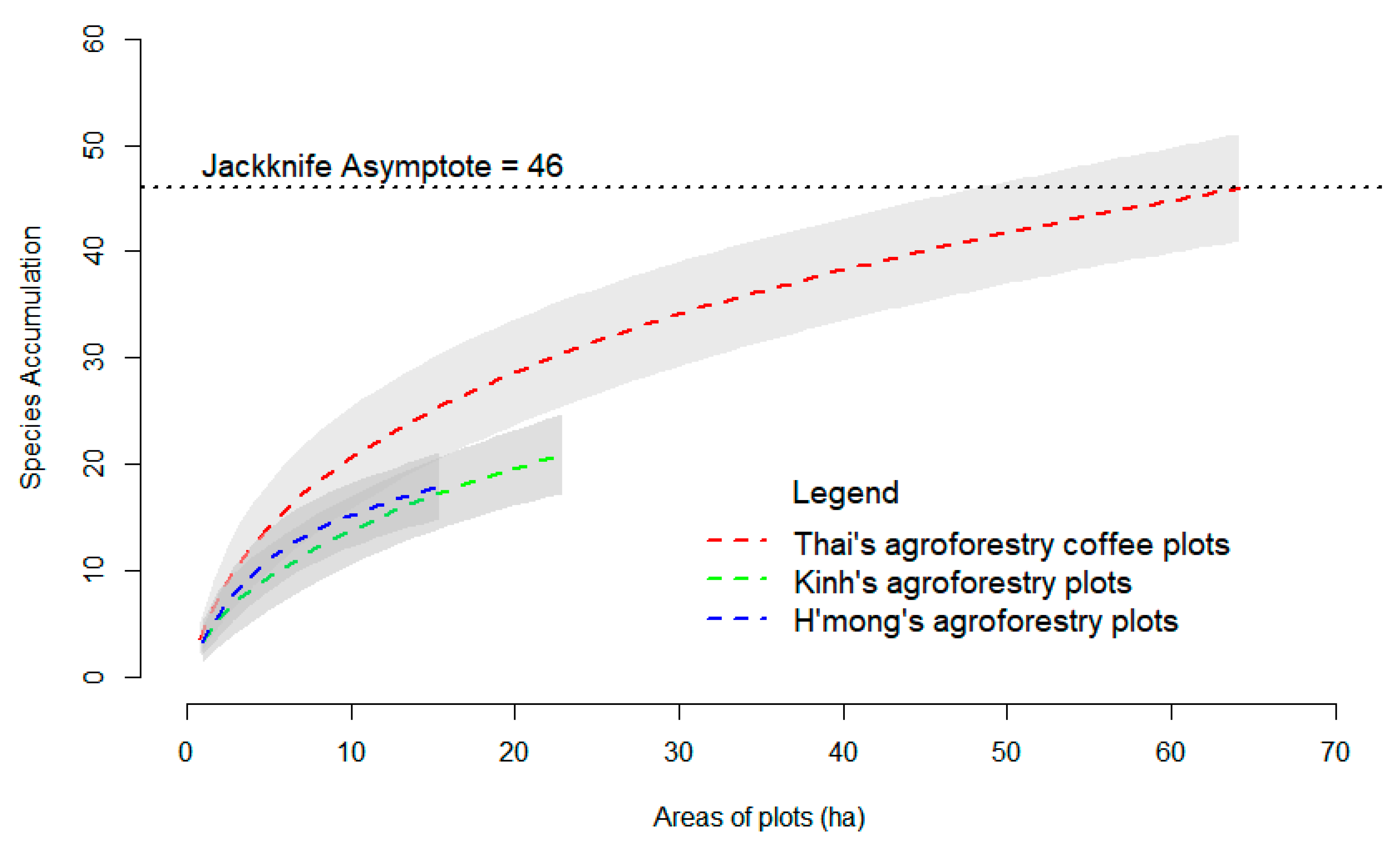
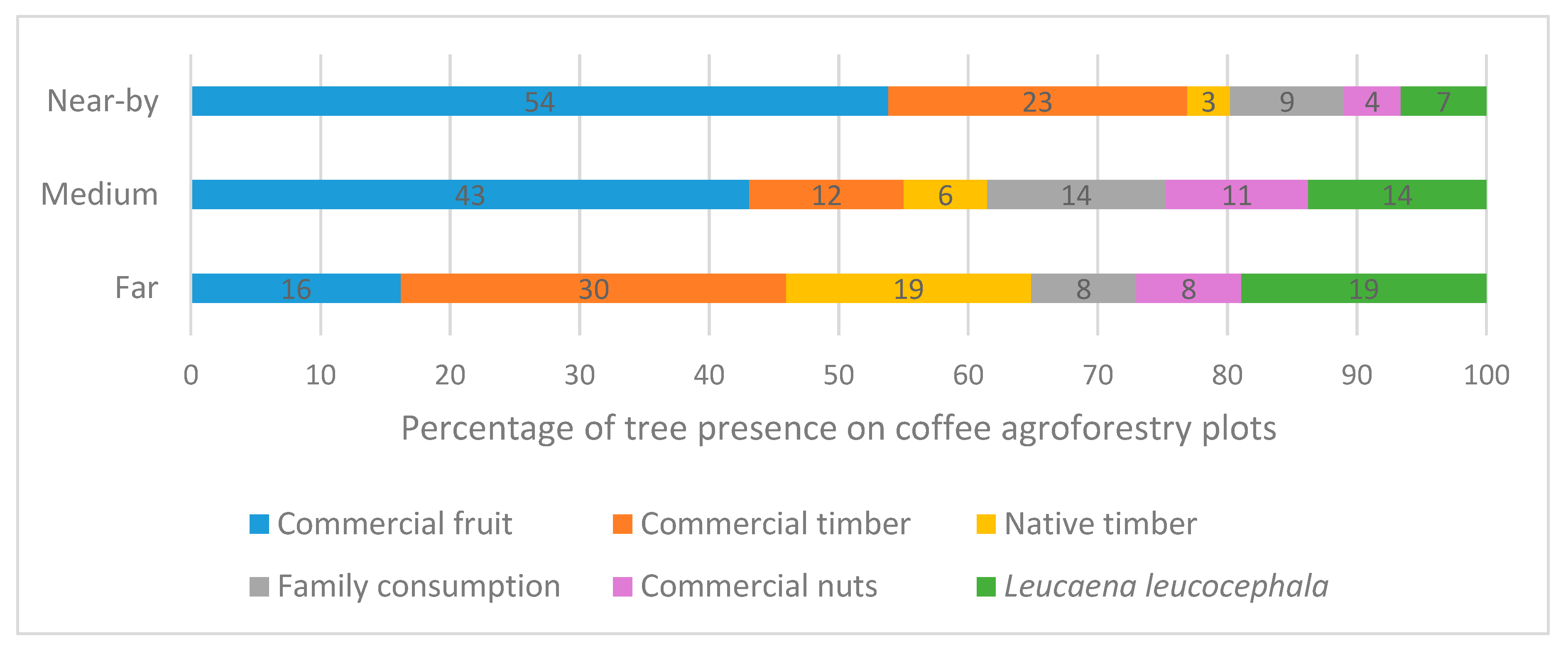
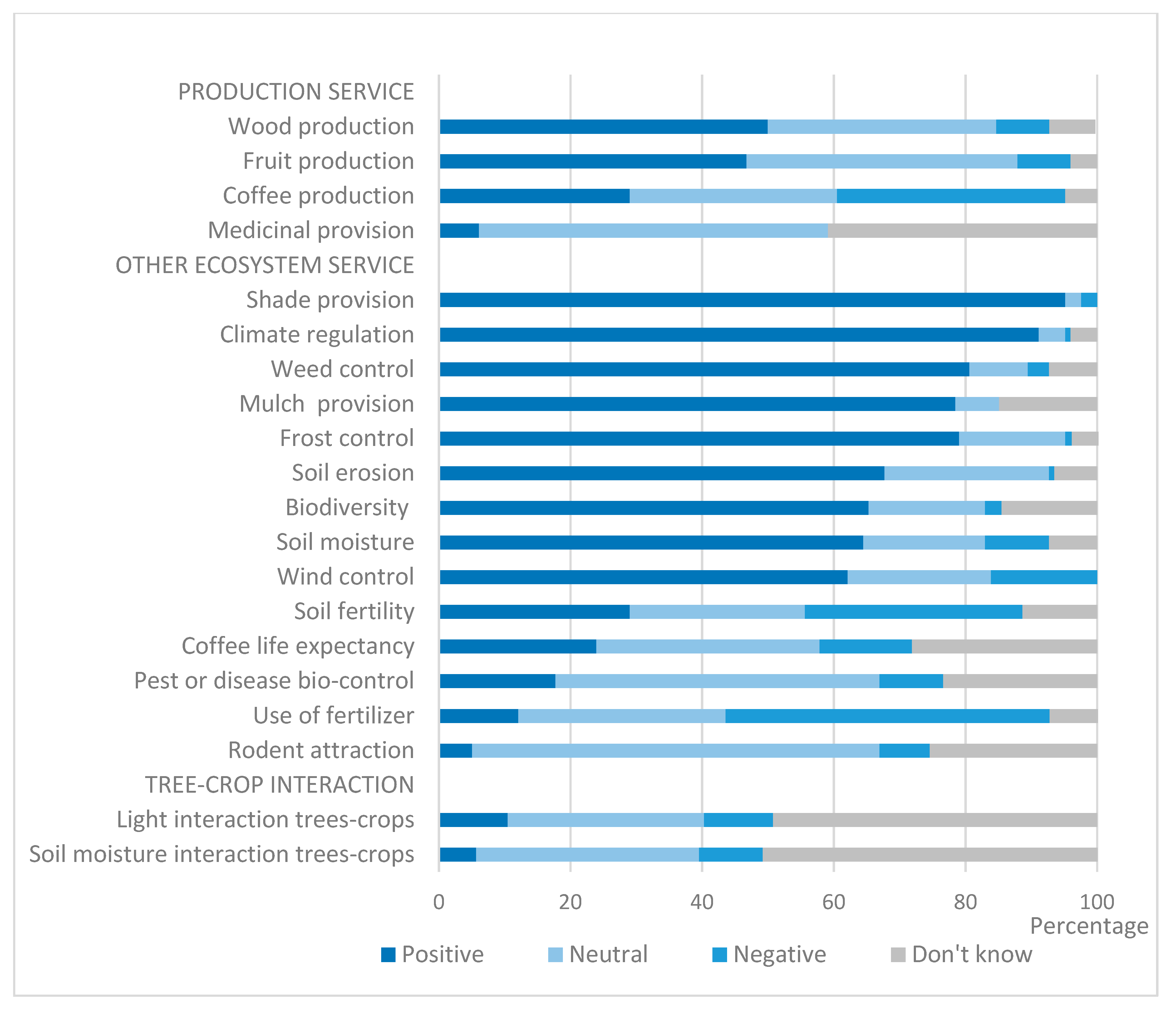
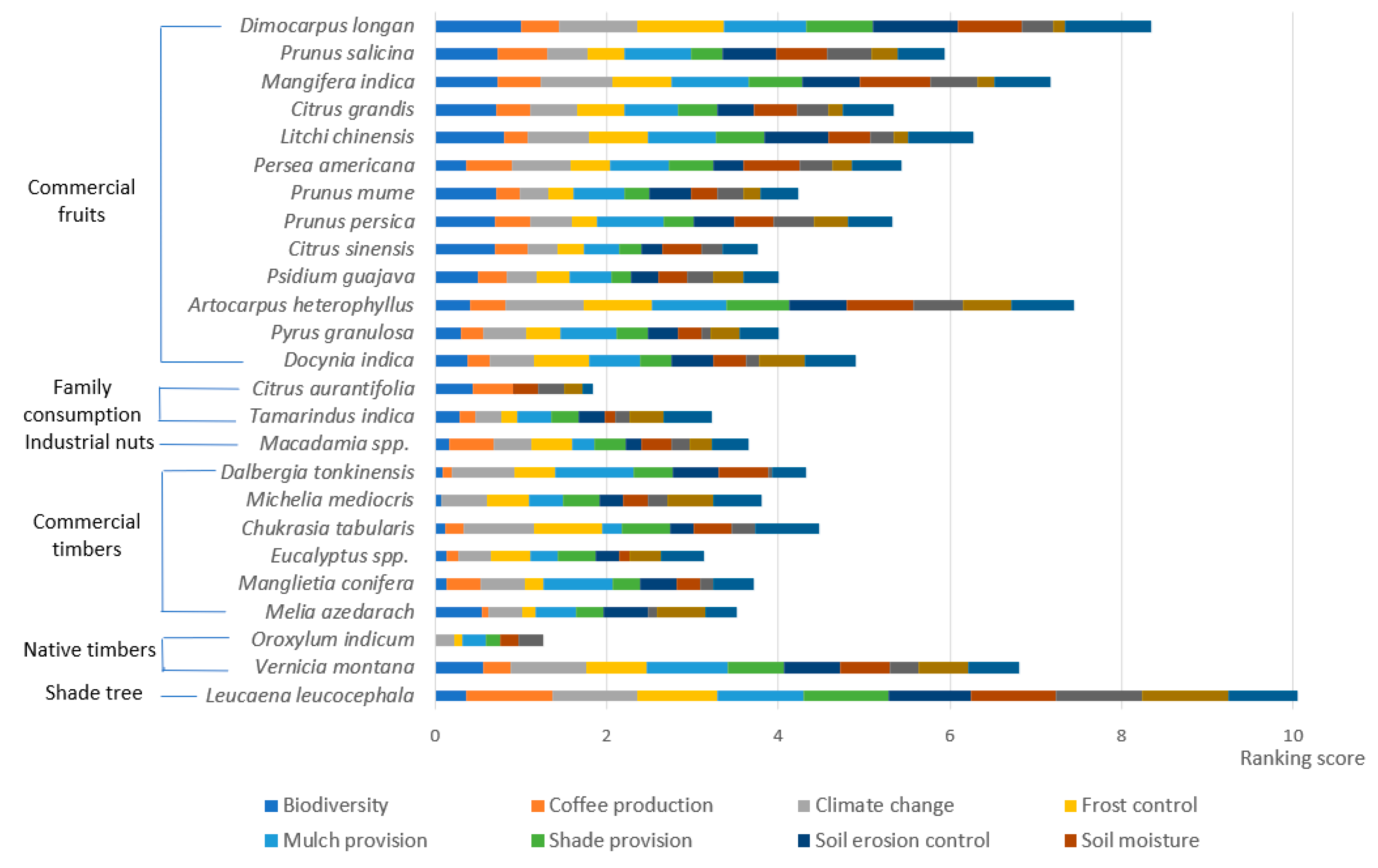
| Social and Farm Characteristics | Total Population | Kinh | Thai | H’mong |
|---|---|---|---|---|
| Total number of respondents | 124 | 25 | 83 | 16 |
| Mean agricultural income (USD/year/household) | 4571 ± 390 | 8762 ± 1286 | 3810 ± 324 | 1762 ± 276 |
| Mean farm area (ha) | 1.50 ± 0.09 | 1.60 ± 0.26 | 1.30 ± 0.10 | 1.90 ± 0.30 |
| Mean number of coffee plots | 2-3 | 2-3 | 2-3 | 2-3 |
| Mean area of coffee plots (ha) | 1.00 ± 0.09 | 1.10 ± 0.16 | 1.00 ± 0.08 | 1.20 ± 0.20 |
| Mean area of agroforestry coffee plots (ha) | 0.80 ± 0.06 | 1.00 ± 0.12 | 0.80 ± 0.07 | 1.00 ± 0.21 |
| Mean distance to main road | 0–2 km | 0–5 km | 0–3 km (Tuan Giao district) or 5–7 km (Muong Ang district) |
| No. | English Name | Scientific Name | Dominant Function | Exotic/Native | Frequencies of Species (%) |
|---|---|---|---|---|---|
| 1 | Longan | Dimocarpus longan | Commercial fruit | Exotic | 46 |
| 2 | Plum | Prunus salicina | Commercial fruit | Native | 43 |
| 3 | Mango | Mangifera indica | Commercial fruit | Exotic | 42 |
| 4 | Leucaena | Leucaena leucocephala | Shade | Exotic | 23 |
| 5 | Jackfruit | Artocarpus heterophyllus | Family consumption/Commercial fruit | Native | 22 |
| 6 | Pomelo | Citrus grandis | Commercial fruit | Exotic | 22 |
| 7 | Melia | Melia azedarach | Commercial timber | Exotic | 20 |
| 8 | Peach | Prunus persica | Commercial fruit | Native | 15 |
| 9 | Macadamia | Macadamia spp. | Commercial nut | Exotic | 15 |
| 10 | Avocado | Persea americana | Commercial fruit | Exotic | 13 |
| 11 | Docynia indica | Docynia indica | Commercial fruit | Native | 9 |
| 12 | Guava | Psidium guajava | Commercial fruit | Native | 8 |
| 13 | Orange | Citrus sinensis | Commercial fruit | Exotic | 6 |
| 14 | Lime | Citrus aurantifolia | Family consumption | Native | 6 |
| 15 | Litchi | Litchi chinensis | Commercial fruit | Exotic | 6 |
| 16 | Eucalyptus | Eucalyptus spp. | Commercial timber | Exotic | 6 |
| 17 | Vernicia montana | Vernicia montana | Commercial timber | Native | 6 |
| 18 | Apricot | Prunus mume | Commercial fruit | Native | 5 |
| 19 | Tamarind | Tamarindus indica | Family consumption | Native | 4 |
| 20 | Chukrasia | Chukrasia tabularis | Commercial timber | Exotic | 4 |
| 21 | Dalbergia | Dalbergia tonkinensis | Commercial timber | Exotic | 4 |
| 23 | Manglietia | Manglietia conifera | Commercial timber | Exotic | 3 |
| 22 | Michelia | Michelia mediocris | Commercial timber | Exotic | 3 |
| 24 | Local pear | Pyrus granulosa | Family consumption | Native | 2 |
| 25 | Oroxylum indicum | Oroxylum indicum | Timber/flowers | Native | 2 |
| 26 | Lucuma | Pouteria lucuma | Family consumption | Native | 1 |
| 27 | Fig | Ficus auriculata | Timber/fruit | Native | 1 |
| 28 | Baccaurea sapida | Baccaurea sapida | Timber/fruit | Native | 1 |
| 29 | Bischofia javanica | Bischofia javanica | Timber | Native | 1 |
| 30 | Papaya | Carica papaya | Family consumption | Native | 1 |
| 31 | Star apple | Chrysophyllum cainito | Family consumption | Exotic | 1 |
| 32 | Star fruit | Averrhoa carambola L. | Family consumption | Exotic | 1 |
| 33 | Pomegranate | Punica granatum | Family consumption | Exotic | 1 |
| 34 | Indian Jujube | Indian Jujube | Family consumption | Native | 1 |
| 35 | Pine | Pinus latteri | Commercial timber/resin | Exotic | 1 |
| 36 | Styphnolobium japonicum | Styphnolobium japonicum | Timber | Native | 1 |
| 37 | Teak | Tectona grandis | Timber | Exotic | 1 |
| 38 | Alstonia scholaris | Alstonia scholaris | Timber | Exotic | 1 |
| 39 | Syzygium nervosum | Syzygium nervosum | Timber/leaf/flower | Exotic | 1 |
| 40 | Khaya senegalensis | Khaya senegalensis | Timber | Exotic | 1 |
| 42 | Dillenia Indica | Dillenia Indica | Timber | Exotic | 1 |
| 43 | Tea | Camellia sinensis | Leaf | Exotic | 1 |
| 44 | Zanthoxylum rhetsa | Zanthoxylum rhetsa | Seed/timber | Native | 1 |
| 45 | Agarwood | Aquilaria malaccensis | Timber/resin | Exotic | 1 |
| 46 | Schima wallichii | Schima wallichii | Timber | Native | 1 |
| 47 | Local timber tree (mý) * | Timber | Native | 1 | |
| 48 | Local timber tree (thro) * | Timber | Native | 1 |
| Tree Services | By Ethnic Group | By Proximity to Road | Overall Ranking | ||||
|---|---|---|---|---|---|---|---|
| Kinh | Thai | H’mong | Nearby | Medium | Far | ||
| Coffee production | Leucaena * | Leucaena | Leucaena | Plum | Leucaena | Leucaena | Leucaena |
| Soil fertility | Leucaena * | Leucaena | Leucaena | Leucaena | Leucaena | Leucaena | Leucaena |
| Shade provision | Longan | Leucaena | Leucaena | Longan | Leucaena | Leucaena | Leucaena |
| Climate regulation | Longan | Leucaena | Mango | Longan | Leucaena | Leucaena | Leucaena |
| Soil moisture | Longan | Leucaena | Leucaena | Jackfruit | Leucaena | Leucaena | Leucaena |
| Soil erosion | Longan | Longan | Longan | Longan | Longan | Longan | Longan |
| Wind control | Longan | Longan | Longan | Longan | Longan | Longan | Longan |
| Frost control | Longan | Leucaena | Longan | Longan | Leucaena | Longan | Longan |
| Mulch provision | Plum | Leucaena | Longan | Longan | Jackfruit | Leucaena | Longan |
| Biodiversity | Longan | Longan | Mango | Longan | Longan | Longan | Longan |
| Use of fertilizer | Jackfruit | Leucaena | Leucaena | Leucaena | Leucaena | Peach | Leucaena |
Publisher’s Note: MDPI stays neutral with regard to jurisdictional claims in published maps and institutional affiliations. |
© 2020 by the authors. Licensee MDPI, Basel, Switzerland. This article is an open access article distributed under the terms and conditions of the Creative Commons Attribution (CC BY) license (http://creativecommons.org/licenses/by/4.0/).
Share and Cite
Nguyen, M.P.; Vaast, P.; Pagella, T.; Sinclair, F. Local Knowledge about Ecosystem Services Provided by Trees in Coffee Agroforestry Practices in Northwest Vietnam. Land 2020, 9, 486. https://doi.org/10.3390/land9120486
Nguyen MP, Vaast P, Pagella T, Sinclair F. Local Knowledge about Ecosystem Services Provided by Trees in Coffee Agroforestry Practices in Northwest Vietnam. Land. 2020; 9(12):486. https://doi.org/10.3390/land9120486
Chicago/Turabian StyleNguyen, Mai Phuong, Philippe Vaast, Tim Pagella, and Fergus Sinclair. 2020. "Local Knowledge about Ecosystem Services Provided by Trees in Coffee Agroforestry Practices in Northwest Vietnam" Land 9, no. 12: 486. https://doi.org/10.3390/land9120486
APA StyleNguyen, M. P., Vaast, P., Pagella, T., & Sinclair, F. (2020). Local Knowledge about Ecosystem Services Provided by Trees in Coffee Agroforestry Practices in Northwest Vietnam. Land, 9(12), 486. https://doi.org/10.3390/land9120486




